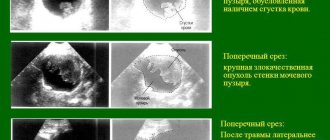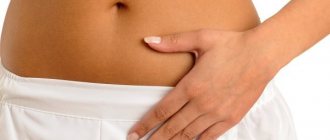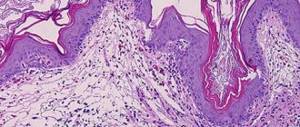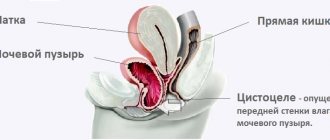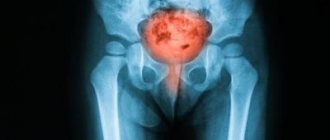In its normal state, the neck of the bladder has an elastic structure, due to which, when urinating, it opens and the unhindered flow of urine into the urethra. When a man is diagnosed with sclerosis of the bladder neck, urination is extremely difficult, up to the absolute impossibility of emptying, which leads to the appearance of residual urine. This condition is explained by the formation of connective tissue scar changes in the structure of the cervix (a narrowed section of the bladder that passes into the urethra). Growing adhesions and scars gradually narrow the lumen of the cervix, and at the peak of the pathology they completely block it, causing acute urinary retention. At such a moment, the man experiences a strong urge, but no fluid is removed. The longer cervical sclerosis progresses, the more residual urine accumulates.
Inflammation of the cervix in men and women
Cystitis of the bladder neck is an inflammatory process in the tissues of the organ that develops as a result of infection of the bladder. The infection enters the body in the following ways:
- with infectious lesions of the external genitalia of a person;
- for kidney infections;
- in case of infection near organs, when pathological bacteria are spread throughout the body by the bloodstream;
- as a postoperative complication if sterility rules are not observed.
The disease affects men and women who are often hypothermic, have weak immunity, and do not take care of their health. With cervical cystitis, a person experiences pain during urination, a disorder develops, and the perception of the urge to urinate is disrupted. A person feels a strong desire to empty the bladder, but when urinating, the volume of urine released is very small. If inflammation is advanced, symptoms of incontinence develop. The person’s temperature rises, the condition rapidly worsens, the pain becomes sharp and severe, weakness, nausea and drowsiness appear.
Return to contents
Preventive methods
To avoid the development of complications in the postoperative period, a number of medical measures are necessary. The drainage installed after transvesical adenomectomy must be removed no later than the seventh day. It is important to quickly restore the process of spontaneous urination.
For his part, the patient is obliged to prevent this condition, closely monitoring his health, and promptly treat inflammatory diseases.
Diseases of the kidneys and urinary system can recur over time. Therefore, the patient must carefully monitor his health, follow all the recommendations and prescriptions of the attending physician, undergo the necessary studies and tests. When the first symptoms appear, the patient should consult a doctor promptly.
Cervical sclerosis
Symptoms of bladder neck sclerosis are characterized by the development of problems with urination and severe pain when trying to go to the toilet.
Sclerosis of the bladder neck is characterized by the formation of scars that arise as a result of inflammation of the mucous tissues of the organ. Obstruction of the bladder neck worries more men who have undergone surgery to treat prostate adenoma. Symptoms in which bladder sclerosis develops are characterized by the development of problems with urination, severe pain when trying to go to the toilet, increased body temperature, sensitivity and irritability. If these signs appear, delaying diagnosis and treatment is dangerous. You cannot self-medicate, it is dangerous to health and does not justify itself.
Return to contents
Diseases, their causes and symptoms
Most often, damage to the neck of the bladder and urethra occurs as a result of an inflammatory disease due to narrowing in this area. If the process could not be cured on time for some reason, then a person may develop a replacement of normal epithelium with one that is not typical for this organ. In this case, the patient experiences a strong burning sensation, frequent urge to urinate and a feeling of incomplete emptying.
The infection enters the cervix in 3 ways:
- ascending - through the external genitalia and urethra if hygiene rules are not followed;
- descending - with the development of inflammation in the kidneys and ureters;
- hematogenously - through the blood.
Inflammation of the cervix in women
Inflammation of the bladder neck is accompanied by fever and painful diuresis.
It is a local infectious process that does not spread to the entire bladder. Women are more susceptible to this complication. It is associated with the anatomical features of the structure of the urethra. In this case, a person experiences pain during urine excretion, and in the case of a long-term process, incontinence occurs. During the acute period, body temperature rises significantly, and the general condition worsens significantly.
Sclerosis in the organ in men
This is the process of replacing normal mucosal cells with scar tissue or collagen fibers. It develops in connection with a long-term inflammatory process. Quite often, sclerosis of the bladder neck occurs after removal of prostate adenoma in men. As a result of the pathology, every attempt to go to the toilet ends in pain and requires significant effort.
Due to long-term sclerosis, the patient may experience stenosis of the bladder opening.
Leukoplakia
This is a pathology in which transitional epithelial cells are replaced by keratinized epithelial structures. They are not able to perform a protective function and neutralize the effect of urine on the walls of the organ. As a result of aggressive exposure, other dangerous diseases arise, such as malignant tumors. The cause of leukoplakia is chronic infection. Pathology is more common in women. In this case, patients experience urinary disturbances, manifested in changes in the amount of urine, nagging pain in the lower abdomen and other unpleasant symptoms.
Development of cystitis
Cystitis affects the entire bladder, as well as the cervix.
This pathology is an inflammation of the entire wall of the bladder, including its neck. The cause of the disease is inflammation, often of a bacterial nature, associated with the rise of an infectious agent up the urethra. Long-term and untreated cystitis can ultimately lead to pyelonephritis and serious kidney problems, including kidney failure.
Cervical stenosis
Occurs with long-term sclerosis as a result of inflammation or surgery. In this case, the outflow of urine is completely obstructed, and in severe cases, acute urine retention occurs. This subsequently causes hydronephrosis and kidney failure, which is a life-threatening condition. Bladder neck stenosis goes through several stages in its development. At first it is only difficulty urinating. After urination, not all urine comes out of the bladder, but some of it remains.
cervical stenosis
Bladder stenosis is a pathological decrease in the lumen of the organ neck. The disease occurs due to untimely treatment of bladder inflammation. The disease is congenital when anomalies develop during the formation of fetal organs in utero. Symptoms of stenosis are similar to those of cystitis: fever, sharp pain when going to the toilet, problems with urination. If stenosis of the bladder neck is not treated, the patient will begin to develop urinary retention, as a result of which inflammatory processes will spread to the kidney tissue.
Return to contents
How to diagnose?
It is necessary to identify the disease in the early stages of its development. This will avoid unpleasant complications and facilitate a simple and quick solution to the problem. For this purpose, ultrasound of the bladder is used. The study is carried out when the organ is completely filled with urine. Using this diagnostic method, obstruction of the bladder neck is determined, but endoscopic probing will help to accurately determine the cause of the problem. It will show a very clear picture of the organ, invisible on ultrasound. A general blood and urine test is mandatory. In the latter, there may be a deviation from the norm in the form of an increase in the number of leukocytes and an increase in the number of bacteria.
Leukoplakia
The symptoms of leukoplakia and cystitis are similar.
Leukoplakia of the bladder neck and urethra is characterized by the replacement of the transitional epithelium (in the normal state) with flat epithelium. The root cause of the disease is untimely therapy and the development of the inflammatory process. But most often the disease develops due to a person being infected through sexual contact, when the partner is a carrier of the herpes virus, chlamydia, trichomoniasis, ureaplasma and gonococcus. Characteristic symptoms of the disease are discomfort, pain and itching when going to the toilet, pain in the lower abdomen, and fever. The symptoms of leukoplakia and cystitis are similar, but the principle of therapy is different, so it is important to distinguish the disease and prescribe a course of adequate therapy.
Return to contents
Symptoms of pathology
The development of pathology is characterized by increased obstruction, which leads to the acute stage of urinary retention. The main symptoms are considered to be:
- frequent urination with a weak stream and small portions of excreted fluid;
- a feeling of incomplete urination and large amounts of residual urine in the bladder;
- reducing the time between the urge to deurinate;
- frequent deurination at night, when the body should rest (up to a frequency of every 15 minutes);
- imperative, or false, urge to urinate.
If the listed symptoms are supplemented by discomfort in the perineum, aching pain in the lower abdomen, as well as pain when urinating, then prostatocystitis is added to the pathology. If blood streaks appear in the semen, the inflammation spreads to the seminal vesicles, and is called vesiculitis.
Sclerosis of the bladder in the neck area disrupts the evacuation function, and residual urine remains in a large volume. When the walls of the organ are overstretched and there are disruptions in the innervation (if the patient has multiple sclerosis), atony of the surfaces occurs, which provokes a worsening of the pathology.
Stagnant urine is characterized by the active proliferation of pathogenic bacteria, which pass through the ascending pathways to the upper organs of the urinary system. Thus, pyelonephritis occurs in the kidneys, in their calyces and pelvis. If timely treatment and urine drainage are ignored, the complication leads to renal failure.
More on the topic: What does it mean when the relative density of urine is increased?
Diagnostics
To make an accurate diagnosis and begin effective therapy, the doctor collects all the information about the patient, asks about the symptoms of the disease, and how long ago it began to bother you. If symptoms confirm the development of inflammation of the bladder neck, the patient undergoes laboratory and instrumental examination. A general blood test is taken, which will show the development of inflammation in the body and the presence of an infectious pathogen.
Next, the doctor takes a bacteriological culture from the patient’s genital organs to identify which microorganism has affected the organ. Women are advised to undergo an examination by a gynecologist and an ultrasound examination, which will help identify concomitant diseases. If necessary, the patient is advised to undergo cytoscopy and take tissue samples from the affected organ for histological examination. After the doctor receives the research data, a course of drug therapy will be prescribed or surgical removal of the scars will be indicated.
Return to contents
Modern diagnostic methods
The diagnosis is made by a urologist based on the patient’s complaints:
- difficulty urinating;
- urinary retention;
- the appearance of the results of a recent operation.
The patient undergoes ascending contrast urethrography, uroflowmetry, and urethroscopy. These methods will identify the presence and assess the degree of narrowing of the bladder neck. Only a specialist can make the correct diagnosis, since it is necessary to carry out a differential diagnosis with the following pathologies:
- urethral stricture;
- false move;
- prostate sclerosis;
- prostatitis.
Treatment of diseases of the bladder neck
Conservative methods
Antibiotics, vitamins and immunostimulants are prescribed to cure inflammatory processes.
To cure inflammatory processes in the bladder, the doctor prescribes a course of broad-spectrum antibiotic therapy if complicated inflammation develops, and narrowly targeted drugs when a specific infectious agent is known. Depending on the severity of the disease and the severity of the inflammation, the course of antibiotics lasts from 7 to 14 days. Medicines that accelerate the regeneration of damaged tissues, vitamins and immunostimulants are indicated. If such a course of drug therapy does not bring results, doctors decide to use surgery and remove the pathology.
Return to contents
Surgery
TUR (transurethral resection)
TUR of the bladder neck involves the removal of scars formed on the mucous tissues of the organ as a result of untimely treatment of inflammation. The surgery does not involve resection of the abdominal cavity; during the operation, transurethral resection is used. The operation is performed under general anesthesia, an endoscope is inserted into the cavity of the urethra and the healed tissue on the cervix is excised. After the surgery is completed, a temporary catheter is inserted into the ureter until the organ's functionality is restored after surgery. After surgery, a course of antibiotics and monitoring of the organ using ultrasound examination are indicated. But you need to know that surgery does not always completely eliminate the disease. If you do not follow the doctor's recommendations and neglect your health, even after surgery, there is a risk of relapse.
Return to contents
Treatment of pathology
The approach to treating the problem should be comprehensive. However, drug treatment of pathology is effective only at the initial stages of its development. Timely therapy will help to avoid dangerous and unpleasant phenomena in the future and will prevent the removal of the cervix due to the inability to cope with diseases that provoke its inflammation.
Conservative
To treat diseases of the bladder neck, the following groups of drugs are used:
- antibiotics - to eliminate pathogens;
- anti-inflammatory - will reduce the focus of inflammation;
- painkillers - will relieve the patient of discomfort;
- immunomodulators - activate the body’s defenses and help in the fight against pathogens;
- vitamins - will increase resistance to infections.
The basis of the treatment process for the initial stages of the disease is the use of cephalosporin antibiotics and uroseptics.
Cervical removal
If a person has developed complete stenosis of the bladder, this is an indication for surgery. The operation is performed under general anesthesia. Access is made in the area of the urethra, while the diseased areas of the cervix are excised, and healthy areas are combined using a suture. This operation is called bladder neck tour or transurethral resection. It allows you to get rid of the problem of urinary retention forever.
Traditional methods of therapy
There are a number of oral medications that will help with diseases of the bladder neck. This is the use of radish with honey, milk with tar. It is also useful to eat celery seeds with the addition of a small amount of honey. It is recommended to take a spoonful of olive oil half an hour before meals. They also use douching with decoctions of medicinal herbs, for example, chamomile or calendula. In addition, candles based on mumiyo are used.
Traditional methods
Before treatment with folk remedies, you should consult a doctor.
Before starting treatment for bladder inflammation with folk remedies, the patient should consult a doctor. Traditional therapy gives positive results if it is used in conjunction with drug treatment. For therapy, herbs and medicinal mixtures are used, from which tinctures, infusions and medicinal decoctions are made. Plants such as milk thistle, rose hips and corn silk effectively relieve inflammation and pain symptoms. Regular use of decoctions speeds up healing without having a negative effect on the human body.
- Infusion of corn silk. To prepare, take the stigmas and combine with chamomile flowers and mint, place in a thermos and pour a liter of boiling water. Let it brew for 2-3 hours, drink throughout the day like tea. You can add a spoonful of honey for taste.
- Herbal infusion. To prepare, take dried herbs of St. John's wort, string and chamomile. Place the ingredients in an enamel container, pour boiling water and put on fire. Boil, then leave to steep for 2.5-3 hours. Drink half a glass 3 times a day.
- Infusion of dried mint flowers. Mint also helps treat inflammatory processes in the body and has proven to be an effective anti-inflammatory agent for bladder diseases. To prepare the infusion, take fresh flowers of the plant, place in an enamel container, pour boiling water and simmer over low heat for 10 minutes. Then let it cool to a comfortable temperature and take 2-3 glasses every day as tea, adding a spoonful of honey to taste.
Return to contents
Strengthening the Bladder
There is a symptom of “overactive bladder”, which is expressed by strong sudden urination, even if very little fluid has accumulated. Often the patient does not have time to get to the toilet before involuntary urination occurs.
In such cases, it is recommended to resort to a “telephone prompt”: the phone beeps every 2 hours. You need to empty your bladder even if there is no urge. After some time, you will develop the habit of emptying your bladder at two-hour intervals.
The bladder is strengthened by taking baths with dried wildflowers
250 g of dry plants are poured into 5 liters of boiling water. Simmer for 1 hour, filter after two hours of infusion. Take twenty-minute baths daily.
Prevention
Diseases of the genitourinary system and kidneys tend to recur under certain circumstances. Therefore, the patient needs to constantly monitor the health and condition of the internal genitourinary organs. After undergoing therapy, take urine tests and undergo an ultrasound of the abdominal organs every six months. It is recommended to take care of personal hygiene, stay warm, take vitamins, and follow the rules of a healthy lifestyle. If the first symptoms of the disease begin to appear, immediately seek medical help.
The content of the article:
Sclerosis of the bladder neck is the proliferation of connective tissue in the area of the bladder neck, caused by an inflammatory process spreading to the bladder wall.
Pathology develops as a result of complications after surgery on the prostate gland. It should be noted that in the development of this pathology, it does not matter how the surgical intervention was performed: open or endoscopic.
On the other hand, bladder neck sclerosis can be congenital or acquired.
Separately, the sclerosing process in the cervical region is considered in Marion's disease, which is idiopathic in nature (congenital changes in the neck of the bladder).
Diagnostic examination
Since sclerosis of the bladder neck has similar symptomatic manifestations to the clinical picture of other obstructive complications of the postoperative period (urethral strictures, false passages, prostate sclerosis), a clear differentiation of these pathologies is required.
The following principles are included in the basis of diagnostic measures:
- At the initial appointment, the urologist listens to the man’s complaints about impaired urination or the inability to empty the bladder in the usual way, clarifies information regarding previous surgical interventions on the prostate gland and the nature of the postoperative stage.
- The localization and severity of bladder outlet obstruction is determined using ascending contrast urethrography. If the act of miction is preserved, UFM urethroscopy is performed.
- Important diagnostic data can be obtained from the results of transrectal Doppler echocardiography.
- Radiation research methods are used.
- Laboratory screening of urine and blood and a test for PSA levels in the blood are indicated.
- Ultrasound of the bladder, kidneys, prostate gland.
- Possible x-ray of the urethra, uroflowmetry.
There is another relatively new method - multispiral computer voiding cystourethrography. The study allows you to study a specific segment of the urinary canal by obtaining a layer-by-layer image. In this case, three-dimensional reconstruction and virtual endoscopy of the bladder are performed. The diagnosis can be definitively confirmed by the results of histological examination of the biopsy specimen.
Symptoms of the pathological process
This pathological process is characterized by a progressive increase in bladder outlet obstruction, and the final result may be acute urinary retention.
Symptoms of bladder outlet obstruction include complaints of:
• weakening of the urine stream,
• frequent urination in small portions, • a feeling of incomplete excretion of urine, • repeated urination a short period of time after the main one, • repeated trips to the toilet at night, • false (imperative) urges.
If the symptoms described above are accompanied by complaints of pain in the lower abdomen, discomfort in the perineum, pain when urinating, then most likely we are talking about associated prostatocystitis. The appearance of blood streaks in the sperm (hemospermia) indicates that the inflammatory process has spread to the seminal vesicles (vesiculitis).
With sclerosis of the bladder neck, the evacuation function is impaired, and therefore the volume of residual urine reaches significant values.
Against the background of overstretched walls and impaired innervation, atony of the bladder walls occurs, which further aggravates the pathological process.
In stagnant urine, pathogenic microorganisms actively multiply, which spread upward to the upper floors of the urinary system, which leads to the development of pyelonephritis (inflammation of the calyces and pelvis of the kidneys).
If the issue of urine drainage is not resolved in a timely manner, chronic renal failure will become a complication.
Differential diagnosis is carried out with:
• prostatic hyperplasia,
• malignant neoplasm of the bladder, • acute inflammation in the prostate, • urethral stricture, • cystitis, • traumatic injury to the urethra.
Symptoms of narrowing of the cervix
Manifestations of pathology include varying degrees of urination disorders:
- difficulty urinating;
- soreness;
- frequent urge to go to the toilet due to the inability to completely empty the bladder in one urination;
- urination in small portions;
- lack of urination (in later stages);
- pathological changes in urine test parameters.
The insidiousness of the pathology is that it is gradual but steadily progressing. And frequent visits to the toilet, at the beginning, ends, in a late stage, in a life-critical state of complete cessation of urine outflow. Then the only treatment option is emergency drainage of the bladder through the abdominal cavity (cystostomy). Less critical, but severe complications are chronic, wrinkled bladder, chronic cystitis.
Our doctors
Diagnostic criteria
Instrumental diagnostics
To confirm sclerosing changes in the cervical area, in addition to the generally standard laboratory examination methods for all surgical interventions, the following is performed:
• ascending contrast urethrography,
• urethroscopy, • uroflowmetry, • TRUS (ultrasound diagnosis of the prostate through the rectum), • ultrasound examination of the bladder with monitoring of residual urine.
Reliable confirmation of the diagnosis is possible as a result of a biopsy, which is carried out at the time of transurethral resection of the changed segments of the cervix.
Laboratory tests required for hospitalization for surgical treatment
To complete the picture and to reduce complications from the operation to a minimum, it is necessary to perform the following tests:
• UAC, OAM, Nechiporenko test,
• blood biochemistry, • blood for syphilis, hepatitis B and C, HIV infection, • smear for sexually transmitted infections, • PSA blood.
As a rule, with sclerosis of the bladder neck, there are no signs of an inflammatory process in the UAC and TAM.
Ultrasound of the prostate, kidneys, and bladder helps diagnose chronic inflammation of the male genitourinary system and other pathologies, namely:
• prostatitis,
• stones, bladder diverticula, • chronic pyelonephritis, • chronic cystitis, • vesiculitis, • large amounts of residual urine.
Normal levels of residual urine in a healthy person do not exceed 25 ml.
How is diagnosis carried out?
Differential diagnosis is carried out if a number of diseases are suspected: prostatic hyperplasia, malignant neoplasms in the bladder, urethral stricture, acute inflammatory processes in the prostate area, if there is cystitis and any mechanical damage to the urethra.
Instrumental diagnostics are carried out in case of changes due to sclerosis of the bladder in the neck, and urethroscopy, ultrasound through the rectum, uroflowmetry, ascending urethrography using a contrast agent, as well as ultrasound of the bladder to measure the volume of residual urine are performed. The diagnosis can also be confirmed by a biopsy, which is done during transurethral resection of the damaged segments of the cervix.
General treatment criteria
Treatment options include surgery (one-stage or two-stage) and symptomatic drug therapy.
To resolve the situation, an epicystostomy (removal of a catheter from the bladder through an artificially created fistulous tract) is performed as a temporary measure in some cases, followed by the prescription of antibacterial therapy. This will be the first stage of treatment.
With a functioning epicystostomy, a man can walk for several months until clinical and laboratory parameters normalize and the acute inflammatory process subsides.
It should be noted that prolonged urine diversion through epicystostomy drainage contributes to a decrease in bladder volume, which will subsequently lead to the development of symptoms of neurogenic disorders. Therefore, it is necessary to clamp the catheter several times a day, this will allow the organ to maintain the required volume and avoid dysuria in the postoperative period.
After acute inflammation in the male genitourinary area of any location subsides, an attempt to perform a radical operation is possible.
The most reasonable choice would be to perform endoscopic laser surgery - transurethral resection of pathologically altered areas of the bladder neck. The effectiveness of this technique is about 90%.
Contraindications to the operation
Since TUR is considered a minimally invasive surgical procedure, there are practically no contraindications to treatment.
The exceptions are concomitant infectious diseases in the acute period, pathological changes in the osteoarticular apparatus that do not allow the hips to be moved apart to perform the intervention, severe conditions of the cardiovascular and respiratory systems, and severe liver failure.
Among the advantages of the operational aid, it is necessary to note:
• minimally invasive,
• “bloodless”, • short rehabilitation period, • no need for long-term postoperative catheterization, • low percentage of complications, • reduced risk of further growth of connective tissue, • possibility of repetition without great risks for the patient.
In endoscopic urology therapy for bladder neck sclerosis, the main goal is to reduce the number of complications that develop as a result of open surgery in the early and late postoperative period. The mortality rate when performing TUR is significantly lower compared to open surgical treatment.
Prediction for patients
Sclerosis of the bladder neck is a complex disease of the urinary system, but the prognosis for most patients is within the limits of satisfaction. The pathology is treatable, but it occurs in several stages; therapy is complex and expensive; in some cases, sclerosis of the bladder neck can be cured by doctors.
Sclerosis of the bladder neck sometimes provokes relapses, often they appear in sudden urinary incontinence, the symptoms of a new round of the disease are ambiguous
- the temperature is within normal limits;
- the urinary system gives illogical failures;
- the patient's well-being does not deteriorate.
Doctors can control sclerosis of the bladder neck and its harmful manifestations by implanting silicone particles of the organ. This helps to improve the patient's urination. A complication in this case is stenosis of the bladder neck; if this pathology is present in the human body, it will not be easy to solve the problem with implantation.
The bladder neck is a jewel of the urinary system; its health affects the condition of the entire body. Therefore, the occurrence of sclerosis of the bladder neck in men is a complex manifestation of disorders. In most cases, immediate surgery is required.
Postoperative period
After endoscopic surgery for resection of altered areas of the bladder neck, massive antibacterial therapy is prescribed to prevent inflammation and painkillers.
There is a possibility that after a TUR of the bladder neck, an “irrigation” system will be installed: a transurethral Foley catheter with the introduction of antiseptic solutions through it. This measure avoids blockage of the urethra with blood clots and maintains the full outflow of urine. In addition, due to the constant diversion of urine and reduced pressure on the walls of the bladder, the risk of bleeding from vessels damaged during surgery is reduced.
The irrigation system is installed for 3-4 days, and after removal of the Foley catheter, normal urination is restored.
The patient is prescribed a special gentle diet with the exclusion of salty, spicy, sour foods with increased fluid intake.
The patient may be bothered by pain when urinating frequently, or blood in the urine, but with antibiotic therapy, such phenomena disappear within a week.
Inpatient treatment lasts approximately 8-10 days; during this period, as a rule, the result of a histological examination is ready.
If no evidence of tumor pathology is identified, then the patient, after resection of the bladder neck, is discharged under the supervision of the outpatient service.
Staging and symptoms
Stagnation of urine can cause inflammation of the bladder walls
Whatever the provoking factors, signs of bladder sclerosis in men always manifest themselves in the same way.
Judging by the clinical picture, the degree of pathology can be determined:
- First stage or compensated . Characteristic signs: weak stream, frequent desire to urinate (especially during night sleep). The main distinguishing nuance is that no urine remains in the bladder because it is completely emptied. Typically this period lasts about three years.
- Second stage or subcompensated. Clinical manifestations become more pronounced: the urge becomes more frequent, possible delays or cases of enuresis, hematuria, while the bladder does not completely empty. The ureters and renal pelvis enlarge. A biochemical blood test shows a moderate increase in nitrogen components. An increase in protein indicates the presence of inflammation and the first signs of renal failure.
- Third stage or decompensated. This period is characterized by the presence and progression of renal failure, constant urine retention and problems with urination: going to the toilet causes great problems (liquid flows out very little), hematuria is quite often recorded.
Important. If a man experiences difficulties associated with the functioning of the excretory system, or the first signs appear, you should not wait for the condition to worsen, but it is better that the patient is consulted by a urologist. The cost of saving time or not wanting to visit a clinic can be quite serious. You should always remember that treatment in the early stages is much more effective.
Possible complications
Despite the fact that TUR is one of the most gentle endoscopic operations, there is a risk of possible complications:
• ineffectiveness of surgical treatment,
• perforation of the organ wall, • bleeding, • development of urethral stricture, • inflammatory diseases of the male genital organs, • urinary incontinence.
With sclerosis of the bladder neck, the prognosis for recovery is satisfactory. All possible complications can be corrected.
For persistent symptoms of urinary incontinence, it is possible to perform sling surgical interventions or implantation of an artificial sphincter.
Sclerosis of the bladder neck is diagnosed if scar tissue forms in the area where the bladder enters the urethra. At the same time, the lumen narrows and the evacuation of urine is disrupted. Only men are susceptible to pathology, which in the vast majority of cases is a consequence of unsuccessful treatment for inflammation of prostate adenoma.
Often sclerosis of the bladder neck in men appears as a result of surgery for prostate adenoma. The main symptom of the disease is difficulty urinating. Sometimes there is complete retention of urine.
Causes of pathology
Most often, sclerosis develops for the following reasons:
- complication in the postoperative period;
- violation of the technique of performing the operation;
- the body's predisposition to scarring;
- repeated inflammation in the prostate.
What the disease threatens
An overstretched bladder muscle does not ensure normal contraction of the bladder, which causes the development or exacerbation of pyelonephritis. Infection of stagnant urine leads to kidney failure, which is fraught with diseases of the cardiovascular and nervous systems, and poisoning of the body.
Diagnostics
The doctor first makes a diagnosis of “sclerosis of the bladder neck” based on the patient’s complaints:
- pain during urination;
- acute urine retention.
The medical history includes information about possible surgical interventions, complications suffered by the patient
To confirm the preliminary diagnosis, contrast urethrography is used. If urination is preserved, the necessary information is obtained using uroflowmetry and urethroscopy. The necessary information can be obtained by transrectal ultrasound examination. It is also possible to identify other urological pathologies.
Treatment
The patency of the vesicourethral segment can only be restored through surgical intervention. Modern technologies make it possible to perform operations without running to incisions, accessing through the urethra.
If it is impossible to urinate, they resort to two-stage therapy: install drainage a month before surgery.
With one-stage therapy, the bladder neck is corrected. Scar tissue is eliminated by TUR, laser, or open surgery.
If after several operations it is not possible to get rid of relapses, they resort to the help of intraurethral metal stents in order to mechanically impede the scarring process.
In this case, it is necessary to leave a passage for urine removal. Drug therapy with antibiotics is needed to reduce the activity of pathogenic infections in the urinary system.
The most effective treatment of the disease is carried out using the scar TUR method.
Period after surgery
To prevent inflammatory processes after surgery for sclerosis of the bladder neck, antibiotic therapy is used, which cannot fully guarantee that in the postoperative period concomitant pathologies will not arise in a weakened body:
- urethritis,
- epididymitis,
- orchiepididymitis.
After completing hospital treatment, it is advisable to continue the course of antibacterial therapy under the supervision of a physician. If sclerosis of the bladder neck recurs after surgery, a repeat TUR of the scars should be performed.
Prevention
To prevent the development of sclerosis of the bladder neck, you need to constantly monitor your health, in particular the genitourinary organs. If you begin to experience discomfort during urination, pain in the kidney area, or urethral burning, you should immediately see a doctor. Sclerosis of the bladder neck is easier to suppress in the initial stage.
Strengthening the Bladder
There is a symptom of “overactive bladder”, which is expressed by strong sudden urination, even if very little fluid has accumulated. Often the patient does not have time to get to the toilet before involuntary urination occurs.
In such cases, it is recommended to resort to a “telephone prompt”: the phone beeps every 2 hours. You need to empty your bladder even if there is no urge. After some time, you will develop the habit of emptying your bladder at two-hour intervals.
The bladder is strengthened by taking baths with dried wildflowers
250 g of dry plants are poured into 5 liters of boiling water. Simmer for 1 hour, filter after two hours of infusion. Take twenty-minute baths daily.
Forecast
The prognosis will be favorable if the therapy and recovery period are carried out correctly. The result of correct treatment of bladder neck sclerosis will be:
- restoration of urinary function;
- removal of suprapubic drainage.
Statistics show that only in 20% of cases does a relapse occur due to the patient’s dishonest attitude towards the doctor’s recommendations. Another reason may be the characteristics of the patient’s body.
The bladder is an important unpaired organ responsible for excreting urine from our body. Normally it is located in the lower abdomen, behind the pubic bone. Men and women have the same bladder, with the only difference being that in men the length of the urethra is 15 centimeters, in women - 3.
Treatment of the bladder with folk remedies
If you feel pain or discomfort in your bladder, you should be wary and get examined, as this may be a symptom of a serious illness. First, let's briefly talk about bladder diseases.
Cystitis This is the most common inflammation of the bladder. If you constantly feel the urge to urinate, but urine is released literally in drops and is accompanied by a burning sensation and pain, most likely it is cystitis. Sometimes with this disease the body temperature rises and blood can be seen in the urine.
Urolithiasis Simply put, it is urolithiasis. Stones and sand form in the bladder. The disease is characterized by frequent painful urination, with cloudy urine, sometimes mixed with blood, and lower back pain.
Tumors New growths in the bladder can be benign or malignant. According to some reports, people whose work involves constant contact with aniline dyes are at risk.
Cancer is more common in men than in women. Smokers and people exposed to aniline dyes are at risk of developing bladder cancer. The patient's urine is intensely stained with blood. If you notice a large amount of blood in your urine, run to the doctor!
Leukoplakia The name of this disease literally translates as “plaque”. From this it is clear that the mucous membrane of the bladder is literally lined with foreign growths, replacing healthy cells. The disease is expressed by pain in the lower abdomen, a constant desire to go to the toilet, but urination does not occur.
Bladder diseases
Atony A patient with atony is unable to control urination. When the bladder is full, a person does not feel the urge and urine begins to come out spontaneously. The main cause of the disease is spinal cord injury.
Polyps Polyps can be any size - from a few millimeters to several centimeters. There are almost no symptoms, except sometimes blood in the urine.
Cystocele Simultaneous prolapse of the vagina and bladder. In advanced cases, tissues may protrude outward. Incomplete emptying of the bladder and, as a result, during stress, for example, coughing or laughter, urine begins to be released spontaneously.
Hyperactivity The name speaks for itself. This means that the patient has a frequent urge to urinate, more than eight times a day. The patient is unable to hold urine and if there is no toilet nearby, what will happen will happen.
Tuberculosis is almost always diagnosed in patients with pulmonary tuberculosis.
Sclerosis This disease affects the neck of the bladder. A sick person has difficulty urinating, sometimes until it stops completely.
Hernia Occurs if the walls of the bladder penetrate through the hernial orifice. Mostly older men are affected.
Endometriosis It is clear that only women get sick, since the disease develops if endometrial cells get on the bladder mucosa.
These are perhaps the most common bladder diseases. Among them there are quite serious diseases that are associated with a risk to life if treatment is not started on time. Therefore, if you feel that something is wrong with your urinary organ, be sure to consult a urologist. And traditional medicine recipes will help you.
Treatment
The patency of the vesicourethral segment can only be restored through surgical intervention. Modern technologies make it possible to perform operations without running to incisions, accessing through the urethra.
If it is impossible to urinate, they resort to two-stage therapy: install drainage a month before surgery.
With one-stage therapy, the bladder neck is corrected. Scar tissue is eliminated by TUR, laser, or open surgery.
If after several operations it is not possible to get rid of relapses, they resort to the help of intraurethral metal stents in order to mechanically impede the scarring process.
In this case, it is necessary to leave a passage for urine removal. Drug therapy with antibiotics is needed to reduce the activity of pathogenic infections in the urinary system.
The most effective treatment of the disease is carried out using the scar TUR method.
Traditional medicine advises
Turnip
For oral administration
- In the spring, sow turnips on your plot. She gradually disappeared from our beds, but in vain. In folk medicine, treatment of the bladder with turnip juice comes first. Boil the squeezed juice for about five minutes and take two spoons up to three times a day.
- When you pull carrots from the garden, do not throw away the tops - this is also a good basis for medicine. Wash the carrot tops, tear them into pieces with your hands and boil about a handful in half a liter of boiling water. Leave covered for an hour. Divide into three servings and drink the day before meals.
- You can also mix carrot tops with parsley. Brew one spoonful of greens and take it in the same way as in the previous recipe.
- Milk with the addition of tar has proven itself well. Add ten drops of birch tar into a glass of heated milk. Drink in three doses throughout the day.
- This recipe is universal. It helps not only with bladder problems, but also cleanses the kidneys. Eat a little pine nut kernels with a little honey every day.
- Radish with honey helps not only with colds. For thirty days, prepare the medicine according to the method suggested for coughs, i.e., cut out the middle of a radish, put honey in it and wait until the juice forms. Take one spoon three times before meals.
- Be sure to try the next method. Mix equal parts celery seeds and honey. Eat a spoonful three times a day.
- Make it a rule to eat a spoonful of olive oil half an hour before meals.
Oats
- Unshelled oats are often found in recipes from traditional healers. It will also be useful for our problem. Boil one glass of oat grains in a steam bath until reduced by half. Strain the broth and add two tablespoons of honey. Place back into the steam bath for five minutes. Drink half a glass three times.
- An infusion of parsley seeds is also recommended by traditional medicine. Lightly crush a spoonful of seeds, pour them into half a liter of boiled, chilled water and leave overnight. In the morning, strain, divide into five parts and drink throughout the day.
- If you are too lazy to make an infusion, or have no time to wait, you can do it easier. Grind parsley seeds into powder and take it on the tip of a knife up to four times a day.
- Yarrow is famous for its anti-inflammatory and hemostatic properties. Therefore, it would be logical to prepare an infusion from it. Brew a spoonful of herbs with a glass of boiling water. After half an hour, strain, squeeze out the raw materials thoroughly and drink three times a day before each meal.
- Recent studies have found that green tea protects the bladder from inflammation due to the catechins it contains. Treatment with tea is simple. Replace your traditional black tea with quality green tea. The study says that for a therapeutic and preventive effect, the amount of tea that you can drink per day during a traditional tea party is sufficient.
Douching and suppositories
Mumiyo
- Fifteen minutes after the procedure, the pain will subside if you douche with mumiyo solution. Dissolve enough mumiyo in a glass of water so that the color of the water is the same as weak coffee and douche.
- Suppositories are also a popular remedy for relieving inflammation and pain. Heat some milk, scoop up half a spoon and dissolve a little mummy in it. Add enough flour to make a candle out of the resulting dough. Insert into the anus before bed. Repeat the procedure every night 10 times.
- Vishnevsky ointment is not exactly a folk remedy, but we cannot keep silent about it, since it is very effective and it is not difficult to use it at home. Use this not-so-nice-smelling tampon ointment for two weeks. It would be superfluous to explain how to place tampons, everyone knows this. It is worth adding that this treatment is only for women.
Compresses
- Compresses are usually done in the evening, before bedtime. Grind the onions into a paste. Spread it evenly on gauze and place it on the bladder area. Be patient and lie there for two hours.
- Potter's clay is also often used for compresses in folk medicine. Mix it with apple cider vinegar, spread it on gauze and place a compress on the lower back, closer to the kidneys.
Warming up
- A popular treatment for cystitis is heating. Boil the potatoes in their jackets, mash them without peeling them. Place a well-heated brick at the bottom of the bucket, and a pan of potatoes on it. Arrange some kind of sitting on the edge of the bucket in advance so that you are comfortable. Sit down, wrap yourself in a blanket and sit for ten minutes. Warm up in this way for a week or a week and a half.
- In the acute stage, chamomile sitz baths help well. Brew three spoons of flowers in five liters of water. Pour the broth into the bath and sit down, making sure that the water does not rise above your waist.
Chamomile baths
Nutrition for bladder problems
Your diet should be balanced and healthy. We will not list what is needed. Let's talk about what you should refuse.
Alcohol of any kind, coffee, carbonated drinks are not allowed. Spicy seasonings, overly salty or sour foods. Unfortunately, many people love chocolate. Tomatoes and all citrus fruits.
Be attentive to your health and live a long, fulfilling life!
Video - Bladder Treatment
- Once a month 34%, 107 votes
107 votes 34%
107 votes - 34% of all votes
- Every six months 29%, 92 votes
92 votes 29%
92 votes - 29% of all votes
- Once a year 27%, 86 votes
86 votes 27%
86 votes - 27% of all votes
- I never get sick 10%, 31 votes
31 votes 10%
31 votes - 10% of all votes
Total votes: 316
10.04.2018
×
You or from your IP have already voted.

